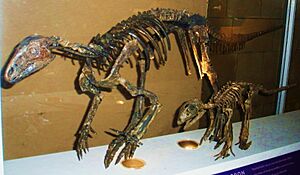Hypsilophodon facts for kids
Quick facts for kids HypsilophodonTemporal range: Lower Cretaceous, 130–125 mya
|
|
|---|---|
 |
|
| Hypsilophodon skeleton. | |
| Scientific classification | |
| Kingdom: | |
| Phylum: | |
| Class: | |
| Superorder: | |
| Order: | |
| Suborder: | |
| Family: |
Hypsilophodontidae
|
| Genus: |
Hypsilophodon
|
| Binomial name | |
| Hypsilophodon foxii Huxley, 1869
|
|
The Hypsilophodon (say: Hip-sih-LOH-fo-don) was a small, speedy dinosaur. It ate only plants. This dinosaur lived about 125 million years ago. It was about 2.3 meters (7-8 feet) long, including its tail. That's about the length of a small car! It weighed about the same as an adult human.
At first, people thought Hypsilophodon was just a young Iguanodon. They even thought it could climb trees! But later, scientists realized it was a totally different species. They also discovered it was built for running, not for climbing trees.
Contents
How Hypsilophodon Lived
Like most small dinosaurs, Hypsilophodon walked on two legs. This is called being bipedal. Its whole body was made for running fast. It had a light body and a low, smooth shape, which helped it move through the air easily. This is called being aerodynamic.
Its long legs and stiff tail helped it keep balance. All these features meant it could run incredibly fast for its size.
What Hypsilophodon Ate
Hypsilophodon ate plants that grew close to the ground. It probably liked young shoots and roots, much like modern deer do today. Its skull had a special shape, with teeth set far back in its jaw. This suggests it had cheeks, which are helpful for chewing food.
It had about 28 to 30 ridged teeth in its jaw. These teeth were arranged in a way that made them sharpen themselves as the dinosaur chewed! Like almost all dinosaurs, especially the ornithischians, its teeth were always being replaced with new ones.
Hypsilophodon's Family Life
Scientists aren't sure how much Hypsilophodon parents cared for their young. However, a very neat nest has been found. This suggests that the parents took some care before the eggs hatched.
Fossils of large groups of Hypsilophodon have been found. This means they likely moved around in herds, just like many animals do today. Because of these reasons, Hypsilophodon and its relatives are often called the "deer of the Mesozoic Era."
Ancient Features of Hypsilophodon
Even though Hypsilophodon lived during the Cretaceous period, it had some older, more basic features. For example, it had five fingers on each hand and four on each foot. Most dinosaurs by the Cretaceous period had fewer digits.
Also, while it had a beak, Hypsilophodon still had pointed, triangle-shaped teeth at the front of its jaw. Most plant-eating dinosaurs by this time had lost their front teeth completely. Some scientists wonder if these front teeth had a special use for Hypsilophodon.
The group of dinosaurs called Hypsilophodontidae stayed pretty much the same for a long time. They lived from the Upper Jurassic period all the way to the end of the Cretaceous. It's possible they were so well-adapted to their way of life that they didn't need to change much. This means there wasn't much selective pressure for them to evolve.
Hypsilophodon's Family Tree
The family of dinosaurs named after Hypsilophodon is called Hypsilophodontidae. Here are some other genera (types) of dinosaurs in this family:
- Agilisaurus
- Anabisetia
- Atlascopcosaurus
- Drinker
- Fulgurotherium
- Gasparinisaura
- Gongbusaurus (= Eugongbusaurus)
- Hexinlusaurus
- Hypsilophodon
- Jeholosaurus
- Leaellynasaura
- Notohypsilophodon
- Orodromeus
- Othnielosaurus
- Koreanosaurus
- Parksosaurus
- Qantassaurus
- Thescelosaurus
- Yandusaurus
- Zephyrosaurus
Images for kids
-
Palaeontologist Thomas H. Huxley, who named Hypsilophodon
-
Fossilized skeleton of Valdosaurus from Great Britain; probable remains of this taxon were previously assigned to Hypsilophodon
-
O. C. Marsh's restoration in tripod-pose










